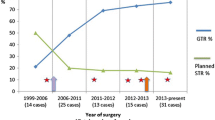Abstract
Objective
Repair of a cerebrospinal fluid (CSF) leak after transsphenoidal surgery (TSS) is usually accomplished using various graft materials. These methods are effective in most, but not all, cases.
Methods
Since 2006, we have been directly suturing the sellar floor dura in patients with an intraoperative CSF leak. Fat and/or fascial grafts were utilized only when a major CSF leak developed. The incidence of postoperative CSF rhinorrhea was compared before and after the suture.
Results
Postoperative CSF rhinorrhea developed in 3.7% (7 out of 188) of cases before 2005, but never since the dural suture was introduced (0 out of 136, 0%; P = 0.0229). Although watertight closure was not achieved in some cases, narrowing the dural defect and supporting the intrasellar graft was attained in every case. Surgical time was approximately 30 min longer in patients who underwent dural suture (148 ± 42 min) than those who did not (119 ± 37 min; P = 0.0001).
Conclusion
Direct suturing of the sellar dura is a simple, safe, and reliable surgical technique for repairing CSF leaks after TSS. Using this procedure, more than 70% of patients with an intraoperative CSF leak can avoid autologous tissue grafts.

Similar content being viewed by others
References
Cappabianca P, Cavallo LM, Esposito F, Valente V, de Divitiis E (2002) Sellar repair in endoscopic endonasal transsphenoidal surgery: results of 170 cases. Neurosurgery 51:1365–1372. doi:10.1097/00006123-200212000-00006
Cavallo LM, Messina A, Esposito F, de Divitiis O, Fabro MD, de Divitiis E et al (2007) Skull base reconstruction in the extended endoscopic transsphenoidal approach for suprasellar lesions. J Neurosurg 107:713–720. doi:10.3171/JNS-07/10/0713
Ciric I, Ragin A, Craig B (1997) Complications of transsphenoidal surgery: results of a national survey, review of the literature, and personal experience. Neurosurgery 40:225–237. doi:10.1097/00006123-199702000-00001
Esposito F, Dusick JR, Fatemi N, Kelly DF (2007) Graded repair of cranial base defects and cerebrospinal fluid leaks in transsphenoidal surgery. Neurosurgery 60 [Suppl 2]:295–304. doi:10.1227/01.NEU.0000255354.64077.66
Guity A, Young PH (1990) A new technique for closure of the dura following transsphenoidal and transclival operations. Technical notes. J Neurosurg 72:824–828
Hadad G, Bassagasteguy L, Carrau RL, Mataza JC, Kassam A, Snyderman CH et al (2006) A novel reconstructive technique after endoscopic expanded endonasal approaches: vascular pedicle nasoseptal flap. Laryngoscope 116:1882–1886. doi:10.1097/01.mlg.0000234933.37779.e4
Kassam A, Carrau RL, Snyderman CH, Gardner P, Mintz A (2005) Evolution of reconstructive techniques following endoscopic expanded endonasal approaches. Neurosurg Focus 19:E8
Kelly DF, Oskouian RJ, Fineman I (2001) Collagen sponge repair of small cerebrospinal fluid leaks obviates tissue grafts and cerebrospinal fluid diversion after pituitary surgery. Neurosurgery 49:885–890. doi:10.1097/00006123-200110000-00020
Kitano M, Taneda M (2004) Subdural patch graft technique for watertight closure of large dural defects in extended transsphenoidal surgery. Neurosurgery 54:653–661. doi:10.1227/01.NEU.0000108780.72365.DC
Nishioka H, Haraoka J, Ikeda Y (2005) Risk factors of cerebrospinal fluid rhinorrhea following transsphenoidal surgery. Acta Neurochir (Wien) 147:1163–1166. doi:10.1007/s00701-005-0586-3
Seiler RW, Mariani L (2000) Sellar reconstruction with resorbable vicryl patches, gelatin foam, and fibrin glue in transsphenoidal surgery: a 10-year experience with 376 patients. J Neurosurg 93:762–765
Spaziante R, de Divitiis E, Cappabianca P, Zona G (2006) Repair of the sella turcica after transsphenoidal surgery. In: Schmidek HH, Roberts DW (eds) Schmidek and Sweet operative neurosurgical techniques: indications, methods, and results, vol 1. Saunders, Philadelphia, pp 390–408
Tindall GT, Woodard EJ, Barrow DL (1993) Pituitary adenomas: general considerations. In: Apuzzo MLJ (ed) Brain surgery: complication avoidance and management. Churchill Livingstone, New York, pp 269–276
Vanaclocha V, Saiz N, Panta F (1998) Repair of dural defects in awkward areas—technical note. Acta Neurochir (Wien) 140:615–618. doi:10.1007/s007010050149
Van Aken MO, Feelders RA, de Marie S, van de Berge JH, Dallenga AHG, Delwel EJ et al (2004) Cerebrospinal fluid leakage during transsphenoidal surgery: postoperative external lumbar drainage reduces the risk for meningitis. Pituitary 7:89–93. doi:10.1007/s11102-005-5351-3
Author information
Authors and Affiliations
Corresponding author
Rights and permissions
About this article
Cite this article
Nishioka, H., Izawa, H., Ikeda, Y. et al. Dural suturing for repair of cerebrospinal fluid leak in transnasal transsphenoidal surgery. Acta Neurochir 151, 1427–1430 (2009). https://doi.org/10.1007/s00701-009-0406-2
Received:
Accepted:
Published:
Issue Date:
DOI: https://doi.org/10.1007/s00701-009-0406-2




